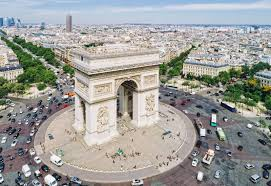The Arc de Triomphe stands as one of the most iconic symbols of Paris, encapsulating the city's rich history and culture. This monumental arch not only commemorates the military victories of the French nation but also serves as a poignant reminder of the sacrifices made for freedom. In this blog, we’ll explore the history, architecture, and cultural significance of the Arc de Triomphe, making it a must-visit landmark for anyone traveling to the City of Light.
Commission and Construction
The idea for the Arc de Triomphe was conceived in 1806 by Emperor Napoleon Bonaparte after his victory at Austerlitz. He wanted to honor the French army and its soldiers, and thus, the design was entrusted to Jean Chalgrin. Construction began in 1806 but faced numerous delays due to political upheaval, financial constraints, and changing regimes. It was finally completed in 1836, long after Napoleon's fall from power.
A Symbol of National Pride
Initially intended to celebrate military achievements, the Arc de Triomphe evolved into a national monument symbolizing French unity and pride. It honors all who fought for France, with names of notable military leaders inscribed on its surfaces. Additionally, the Tomb of the Unknown Soldier, added in 1920, lies beneath the arch, serving as a memorial to the unidentified soldiers who died in World War I.
Design Elements
The Arc de Triomphe stands at 50 meters (164 feet) tall and 45 meters (148 feet) wide, making it one of the largest triumphal arches in the world. Its Neoclassical design features intricate reliefs and sculptures that depict significant historical events and allegorical figures.
Sculptural Details
The arch is adorned with several stunning reliefs, designed by prominent artists such as François Rude and Jean-Pierre Cortot. These artworks illustrate scenes of battles, victories, and the French Revolution, effectively capturing the spirit of the nation.
The View from the Top
Visitors can ascend to the top of the Arc de Triomphe for breathtaking panoramic views of Paris. The rooftop terrace offers an unparalleled vantage point, showcasing landmarks like the Eiffel Tower, the Champs-Élysées, and the sprawling cityscape. The experience is especially magical at sunset when the city glows in golden hues.
A Gathering Place
The Arc de Triomphe is not just a historical monument; it serves as a cultural gathering place. It has been the site of numerous national celebrations, including military parades and commemorations. The annual Bastille Day parade, held every July 14th, features troops marching from the Arc down the Champs-Élysées, a testament to France's military heritage.
Commemoration of Events
The arch has also been a stage for significant historical events. For instance, it witnessed the return of the remains of Napoleon in 1840, symbolizing the enduring legacy of the emperor. In more recent years, it has served as a backdrop for protests and movements, reflecting the ongoing dialogue around national identity and freedom.
Getting There
Located at the western end of the Champs-Élysées, the Arc de Triomphe is easily accessible by public transportation. The nearest metro station is Charles de Gaulle-Étoile, which connects visitors to various parts of the city.
Visitor Experience
The monument is open to the public, and tickets can be purchased for access to the rooftop. Guided tours are also available, offering insights into the history and architecture of this iconic structure. Be sure to explore the small museum located inside the arch, which provides further context about its significance.
Practical Tips
- Best Time to Visit: Early mornings or late afternoons are ideal for avoiding crowds and enjoying the views.
- Photography: Capture stunning photos from both the ground level and the rooftop, especially during the golden hour.
- Events: Check for any special events or commemorations that may be taking place during your visit.
Conclusion
The Arc de Triomphe is more than just an architectural masterpiece; it is a testament to the resilience and spirit of the French people. Whether you're interested in history, architecture, or simply want to soak in the beauty of Paris, this monument is a must-see. As you stand beneath its grand arches and gaze upon the sprawling city, you'll feel a profound connection to the past and the enduring legacy of those who fought for freedom and unity.


No comments:
Post a Comment